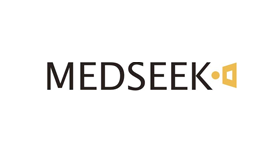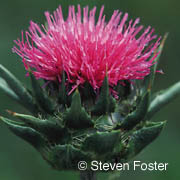Milk thistle
Silybum marianum; St. Mary's thistle
Milk thistle (Silybum marianum) has been used for 2,000 years as an herbal remedy for a variety of ailments, particularly liver, kidney, and gall bladder problems. Several scientific studies suggest that substances in milk thistle (especially a flavonoid called silymarin) protect the liver from toxins, including certain drugs, such as acetaminophen (Tylenol), which can cause liver damage in high doses. Silymarin has antioxidant and anti-inflammatory properties. And it may help the liver repair itself by growing new cells.
Although a number of animal studies demonstrate that milk thistle can be helpful in protecting the liver, results in human studies are mixed.
Liver disease from alcoholMilk thistle is often suggested as a treatment for alcoholic hepatitis and alcoholic cirrhosis, but scientific studies show mixed results. Most studies show milk thistle improves liver function and increases survival in people with cirrhosis or chronic hepatitis. But problems in the design of the studies (such as small numbers of participants and differences in dosing and duration of milk thistle therapy) make it hard to draw any firm conclusions.
Viral hepatitisMilk thistle is widely used in the treatment of viral hepatitis (particularly hepatitis C), however, studies show mixed results. Some studies found improvements in liver function, while others did not. In one study of 16 patients who didn't respond to interferon and ribavirin therapy, milk thistle significantly reduced the viral load of hepatitis C. In 7 of the subjects the virus decreased to undetectable levels after 14 days of therapy.
Mushroom poisoningBased on traditional use, milk thistle has been used as an emergency antidote for poisoning by death cap mushroom (Amanita phalloides). Animal studies have found that milk thistle extract completely counteracts the toxic effects of the mushroom when given within 10 minutes of ingestion. If given within 24 hours, it significantly reduces the risk of liver damage and death.
CancerEarly laboratory studies suggest that silymarin and other active substances in milk thistle may have anti-cancer effects. These substances appear to:
- Stop cancer cells from dividing and reproducing
- Shorten the lifespan of cancer cells
- Reduce blood supply to tumors
Some studies suggest silymarin may favorably supplement sunscreen protection and may help reduce the risk of skin cancer. Other studies suggest milk thistle acts synergistically with chemotherapy. More studies are needed to show whether milk thistle has any effects in the body (not just in test tubes).
Be sure to inform your doctor if you are taking milk thistle. Preliminary studies suggest there may be interactions between milk thistle and cacner prevention drugs including Raloxifene.
Plant Description
Milk thistle is native to the Mediterranean region. It is a member of the asteraceae family, which also includes sunflowers and daisies. It is now found throughout the world. This stout thistle usually grows in dry, sunny areas. Spiny stems branch at the top and reach heights of 5 to 10 feet. The leaves are wide with white blotches or veins. Milk thistle gets its name from the milky white sap that comes from the leaves when they are crushed. The flowers are red purple. The small, hard-skinned fruit is brown, spotted, and shiny. Milk thistle spreads quickly (it is considered a weed in some parts of the world), and it matures in less than a year.
What's It Made Of?
The active ingredient -- the one that protects the liver -- in milk thistle is known as silymarin, a chemical extracted from the seeds. Silymarin is actually a group of flavonoids (silibinin, silidianin, and silicristin), which are thought to help repair liver cells damaged by alcohol and other toxic substances. Silymarin also protects new liver cells from being destroyed by these same toxins. It reduces inflammation (which is why it is often suggested for people with liver inflammation or hepatitis) and is a strong antioxidant.
Most milk thistle products are standardized preparations made from the seeds of the plant, to contain 70% to 80% of silymarin.
Available Forms
- Capsules of standardized dried herb (each capsule contains about 120mg to 140 mg of silymarin)
- Liquid extract
- Tincture
- Silymarin phosphatidylcholine complex
A few studies show that a silymarin-phosphatidylcholine complex may be absorbed more easily than regular standardized milk thistle. Phosphatidylcholine is a key element in cell membranes. It helps silymarin attach easily to cell membranes, which may keep toxins from getting inside liver cells. People who have alcohol-related liver disease should avoid alcohol extracts.
How to Take It
PediatricThere are no studies showing whether or not it is safe to give milk thistle to a child. Liver problems can be serious and should be diagnosed by a physician. Talk to your child's doctor before giving milk thistle to a child.
AdultIf you think you have a liver problem, you should see a doctor. Liver disease can be life threatening.
Precautions
The use of herbs is a time-honored approach to strengthening the body and treating disease. Herbs, however, can trigger side effects, and can interact with other herbs, supplements, or medications. For these reasons, you should take herbs with care, under the supervision of a health care practitioner.
Milk thistle is generally regarded as safe. Side effects are usually mild and may involve:
- Stomach upset
- Diarrhea
- Nausea and vomiting
- Rash (from touching milk thistle plants)
Milk thistle should not be used by pregnant or breastfeeding women.
People with a history of hormone-related cancers, including breast, uterine, and prostate cancer, should not take milk thistle.
DO NOT take milk thistle if you are allergic to ragweed, chrysanthemums, marigolds, chamomile, yarrow, or daisies.
Possible Interactions
Given milk thistle's action on the liver, the stie of most drug metabolism, it would be wise to speak to your doctor if you are taking any medication before using milk thistle. In particular, if you are being treated with any of the following medications, you should not use milk thistle without talking to your doctor first.
- Antipsychotics. Includes butyrophenones (such as haloperidol) and phenothiazines (such as chlorpromazine, fluphenazine, and promethazine).
- Phenytoin (Dilantin). A medication used for seizures.
- Halothane. A medication used during general anesthesia.
- Birth control pills or hormone replacement therapy.
Milk thistle may interfere with the following medications, because both milk thistle and these medications are broken down by the same liver enzymes:
- Allergy drugs. Such as fexofenadine (Allegra) .
- Drugs for high cholesterol. Including statins such as lovastatin (Mevacor, Altocor).
- Anti-anxiety drugs. Including alprazolam (Xanax), diazepam (Valium), and lorazepam (Ativan).
- Antiplatelet and anticoagulant drugs (blood thinners). Including clopidogrel (Plavix) and warfarin (Coumadin).
- Some cancer drugs. Including the breast cancer drug Raloxifene.
- Drugs broken down by the liver. Because milk thistle works on the liver, it may affect drugs broken down by the liver, of which there are many. Speak with your doctor.
Supporting Research
Agarwal R, Agarwal C, Ichikawa H, Singh RP, Aggarwal BB. Anticancer potential of silymarin: from bench to bed side. Anticancer Res. 2006;26(6B):4457-4498. Review.
Asghar Z, Masood Z. Evaluation of antioxidant properties of silymarin and its potential to inhibit peroxyl radicals in vitro. Pak J Pharm Sci. 2008;21(3):249-254.
Barve A, Khan R, Marsano L, Ravindra KV, McClain C. Treatment of alcoholic liver disease. Ann Hepatol. 2008;7(1):5-15. Review.
Bennett JE, Dolin R, Blaser MJ. Mandell, Douglas, and Bennett's Principles and Practice of Infectious Diseases. 8th ed. Philadelphia, PA: Elsevier Saunders; 2015.
Blumenthal M, Goldberg A, Brinckmann J. Herbal Medicine: Expanded Commission E Monographs. Newton, MA: Integrative Medicine Communications; 2000:257-263.
Brantley SJ, Oberlies NH, Kroll DJ, Paine MF. Two flavonolignans from milk thistle (silybum marianum) inhibit CYP2C9-mediated warfarin metabolism at clinically achievable concentrations. J Pharmacol Exp Ther. 2010;332(3):1081-1087.
Ferenci P, Scherzer TM, Kerschner H, et al. Silibinin is a potent antiviral agent in patients with chronic hepatitis C not responding to pegylated interferon/ribavirin therapy. Gastroenterology. 2008;135(5):1561-1567.
Gazak R, Walterova D, Kren V. Silybin and silymarin -- new and emerging applications in medicine. Curr Med Chem. 2007;14(3):315-338. Review.
Giese LA. A study of alternative health care use for gastrointestinal disorders. Gastroenterol Nurs. 2000;23(1):19-27.
Gordon A, Hobbs DA, Bowden DS, et al. Effects of Silybum marianum on serum hepatitis C virus RNA, alanine aminotransferase levels and well-being in patients with chronic hepatitis C. J Gastroenterol Hepatol. 2006;21(1 Pt 2):275-280.
Gufford BT, Chen G, Vergara AG, Lazarus, Oberlies NH, Paine MF. Milk Thistle Constituents Inhibit Raloxifene Intestinal Glucuromidation: A Potential Clinically Relevant Natural Product-Drug Interaction. Drug Metab Dispos. 2015;43(9):1353-1359.
Hoh C, Boocock D, Marczylo T, et al. Pilot study of oral silibinin, a putative chemopreventive agent, in colorectal cancer patients: silibinin levels in plasma, colorectum, and liver and their pharmacodynamic consequences. Clin Cancer Res. 2006;12(9):2944-2950.
Jiang C, Agarwal R, Lu J. Anti-angiogenic potential of a cancer chemopreventive flavonoid antioxidant, Silymairn: inhibition of key attributes of vascular endothelial cells and angiogenic cytokine secretion by cancer epithelial cells. Biochem Biophys Res Commun. 2000;276:371-378.
Köksal E, Gülçin I, Beyza S, Sarikaya O, Bursal E. In vitro antioxidant activity of silymarin. J Enzyme Inhib Med Chem. 2009;24(2):395-405.
Low Dog T. Traditional and alternative therapies for breast cancer. Altern Ther Health Med. 2001;7(3):36-47.
Mayer KE, Myers RP, Lee SS. Silymarin treatment of viral hepatitis: a systematic review. J Viral Hepat. 2005;12(6):559-567. Review.
Michelfelder AJ, Lee KC, Bading EM. Integrative medicine and gastrointestinal disease. Prim Care. 2010;37(2):255-267.
Mulrow C, Lawrence V, Jacobs B, et al. Milk thistle: effects on liver disease and cirrhosis and clinical adverse effects. Evid Rep Technol Assess (Summ). 2000;(21):1-3.
Najm W, Lie D. Dietary supplements commonly used for prevention. Prim Care. 2008;35(4):749-767.
Polyak SJ, Oberlies NH, Pecheur EI, Dahari H, Ferenci P, Pawlotsky JM. Silymarin for HCV infection. Antivir Ther. 2013;18(2):141-147.
Rainone F. Milk thistle. Am Fam Physician. 2005;72(7):1285-1288. Review.
Rakel D. Integrative Medicine. 3rd ed. Philadelphia, PA: Elsevier Saunders; 2012.
Ramasamy K, Agarwal R. Multitargeted therapy of cancer by silymarin. Cancer Lett. 2008;269(2):352-362. Review.
Rambaldi A, Jacobs BP, Iaquinto G, Gluud C. Milk thistle for alcoholic and/or hepatitis B or C liver diseases -- a systematic cochrane hepato-biliary group review with meta-analyses of randomized clinical trials. Am J Gastroenterol. 2005;100(11):2583-2591. Review.
Rotblatt M, Ziment I. Evidence-Based Herbal Medicine. Philadelphia, PA: Hanley & Belfus, Inc; 2002:266-271.
Sadava D, Kane SE. Silibinin reverses drug resistance in human small-cell lung carcinoma cells. Cancer Lett. 2013;339(1):102-106.
Saller R, Brignoli R, Melzer J, Meier R. An updated systematic review with meta-analysis for the clinical evidence of silymarin. Forsch Komplementmed. 2008;15(1):9-20. Review.
Siegel A, Stebbing J. Milk thistle: early seeds of potential. Lancet Oncol. 2013;14(10):929-930.
Vaid M, Katiyar SK. Molecular mechanisms of inhibition of photocarcinogenesis by silymarin, a phytochemical from milk thistle (Silybum marianum L. Gaertn.) (Review). Int J Oncol. 2010;36(5):1053-1060.
Wu JW, Lin LC, Tsai TH. Drug-drug interactions of silymarin on the perspective of pharmacokinetics. J Ehtnopharmacol. 2009;121(2):185-193.
Yu HC, Chen LJ, Cheng KC, Li YX, Yeh CH, Cheng JT. Silymarin inhibits cervical cancer cell through an increase of phosphatase and tensin homolog. Phytother Res. 2012;26(5):709-715.
Zielinska-Przyjemska M, Wiktorowicz K. An in vitro study of the protective effect of the flavonoid silydianin against reactive oxygen species. Phytother Res. 2006;20(2):115-119.

Review Date: 1/1/2017
Reviewed By: Steven D. Ehrlich, NMD, Solutions Acupuncture, a private practice specializing in complementary and alternative medicine, Phoenix, AZ. Review provided by VeriMed Healthcare Network. Also reviewed by the A.D.A.M Editorial team.

